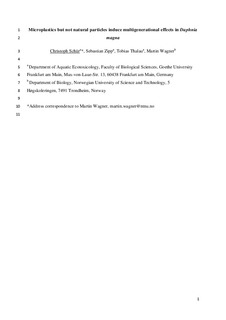| dc.contributor.author | Schür, Christoph | |
| dc.contributor.author | Zipp, Sebastian | |
| dc.contributor.author | Thalau, Tobias | |
| dc.contributor.author | Wagner, Martin | |
| dc.date.accessioned | 2020-02-03T13:39:57Z | |
| dc.date.available | 2020-02-03T13:39:57Z | |
| dc.date.created | 2020-01-17T10:38:41Z | |
| dc.date.issued | 2019 | |
| dc.identifier.issn | 1566-0745 | |
| dc.identifier.uri | http://hdl.handle.net/11250/2639337 | |
| dc.description.abstract | Several studies have investigated the effects of nano- and microplastics on daphnids as key freshwater species. However, while information is abundant on the acute toxicity of plastic beads little is known regarding the multigenerational effects of irregular microplastics. In addition, a comparison of microplastics to naturally occurring particles is missing. Therefore, we investigated the effects of irregular, secondary polystyrene microplastics (<63 μm) and kaolin as natural reference particle on the survival, reproduction, and growth of Daphnia magna over four generations under food-limited conditions. Additionally, we tested the sensitivity of the neonates in each generation to a reference compound as a proxy for offspring fitness. Exposure to high concentrations of microplastics (10,000 and 2000 particles mL−1) reduced daphnid survival, resulting in extinction within one and four generations, respectively. Microplastics also affected reproduction and growth. Importantly, an exposure to kaolin at similar concentrations did not induced negative effects. The sensitivity of neonates to potassium dichromate was not affected by maternal exposure to particles. Taken together, our study demonstrates that irregular PS particles are more toxic than natural kaolin in daphnids exposed over multiple generations under food limitation. Thus, our work builds towards more realistic exposure scenarios needed to better understand the impacts of microplastics on zooplankton. | nb_NO |
| dc.language.iso | eng | nb_NO |
| dc.publisher | Elsevier | nb_NO |
| dc.rights | Attribution-NonCommercial-NoDerivatives 4.0 Internasjonal | * |
| dc.rights | Attribution-NonCommercial-NoDerivatives 4.0 Internasjonal | * |
| dc.rights.uri | http://creativecommons.org/licenses/by-nc-nd/4.0/deed.no | * |
| dc.rights.uri | http://creativecommons.org/licenses/by-nc-nd/4.0/deed.no | * |
| dc.title | Microplastics but not natural particles induce multigenerational effects in Daphnia magna | nb_NO |
| dc.type | Journal article | nb_NO |
| dc.type | Peer reviewed | nb_NO |
| dc.description.version | acceptedVersion | nb_NO |
| dc.source.journal | Environmental Pollution | nb_NO |
| dc.identifier.doi | 10.1016/j.envpol.2019.113904 | |
| dc.identifier.cristin | 1775531 | |
| dc.description.localcode | © 2019. This is the authors’ accepted and refereed manuscript to the article. Locked until 31.12.2021 due to copyright restrictions. This manuscript version is made available under the CC-BY-NC-ND 4.0 license http://creativecommons.org/licenses/by-nc-nd/4.0/ | nb_NO |
| cristin.unitcode | 194,66,10,0 | |
| cristin.unitname | Institutt for biologi | |
| cristin.ispublished | true | |
| cristin.qualitycode | 1 | |

